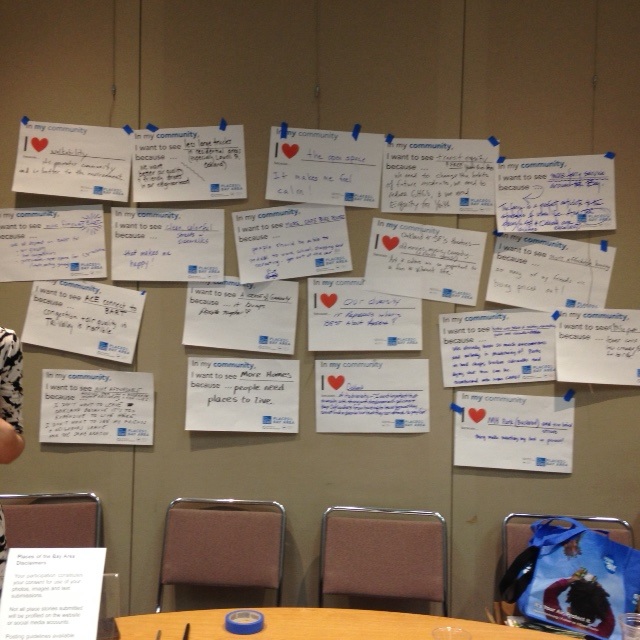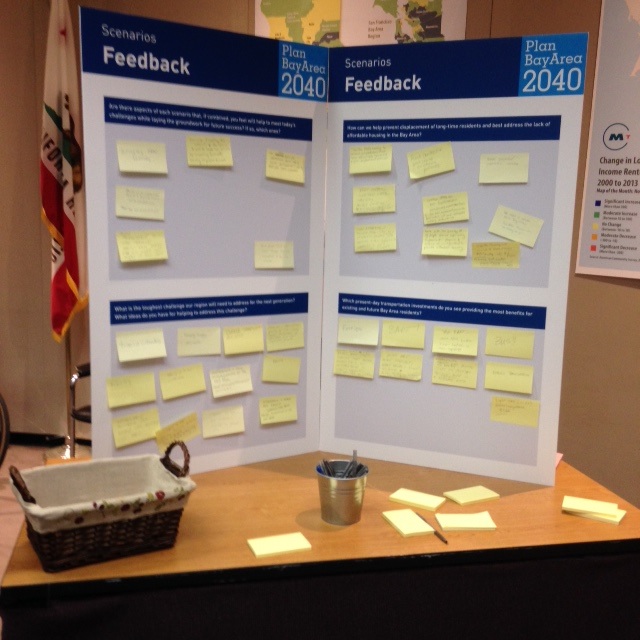Plan Bay Area—the controversial, state-mandated regional “blueprint” for land use and transportation planning through 2040—is back. Actually, it never went away; it just stopped getting attention from the media.
After a stormy public process, the first edition was approved by the Association of Bay Area Governments and the Metropolitan Transportation Commission in July 2013. State law mandates that PBA—officially, our region’s Sustainable Communities Strategy—be updated every four years. We’re now in the middle of the first update.

Specifically, the two agencies have invited the public to “help craft Plan Bay Area 2040” by vetting three alternative scenarios, either online or at one of the county-based open houses. The San Francisco open house was on June 14.

According to background material provided by the agencies, Plan Bay Area “[d]oes not interfere with local land use authority.”
Why, then, do two of the three scenarios propose major changes in a mainstay of San Francisco land use policy, the annual 950,000 square foot cap on office development mandated by voter-approved Prop. M? Scenario #2, Connected Neighborhoods, “[r]aises SF office cap to 1.5 million.” Scenario # 3, Big Cities, “[a]ssumes elimination of caps on office development in San Francisco.”
At the Alameda County open house in Oakland on June 2, I asked MTC Planning Director Ken Kirkey what he and his colleagues were thinking when they decided to propose raising the office cap or doing away with it altogether.
Kirkey said the scenarios were “what-if” projections. “What we expect, based on initial feedback,” he told me, is that the preferred scenario will be “better than any of three” alternatives.
It’s unlikely, however, that the public is going to provide any feedback on the proposed office cap changes. That’s because (as I didn’t realize when I was talking with Kirkey) neither of those changes is referenced in any of the materials provided to the public. I’d spotted them in a briefing that Kirkey had provided to an East Bay city council that I’d seen a few days before the Alameda County open house.
On June 3 I emailed Kirkey and ABAG Planning Director Miriam Chion, who used to work at the San Francisco Planning Department, as follows:
As you are aware, any alteration to Prop. M—and the Big Cities scenario eliminates an office cap entirely—would constitute a major shift in San Francisco’s approach to land use.
But these proposed changes are not noted on the colorful summaries that appear both online and as poster boards at the open houses. Nor do they show up on the Focus on San Francisco page.
Why not?
On June 6, Kirkey replied:
Hi Zelda,
Thanks for your inquiry.
Given the significant constraints on housing supply in the Bay Area, the Draft Scenarios consider how policy changes at various levels would impact the capacity for growth in relation to other Plan goals such as reducing per capita greenhouse gas emissions. Generally speaking changes that impact multiple counties, even if they are controversial and inconsistent with the current Plan Bay Area, such as expanding urban limit lines/urban growth boundaries to allow for more greenfield developed (Main Streets/Scenario 1) are described more widely in Alternative Scenario materials than changes that would impact one county or city, such as a modification to Prop M. Of course, neither MTC nor ABAG has land-use authority, thus any change to Prop M policies are entirely up to San Francisco.
As I mentioned the draft scenarios are “what if” projections, essentially a continuum ranging from Main Streets/Scenario 1 – comparatively greater suburban development and highway investment; Connected Communities/Scenario 2 – a more mid-level approach comparable to the current Plan Bay Area with focused development and investment in cities across the region; and, Big Cities/Scenario 3 – and all in bet on San Jose, San Francisco and Oakland with comparatively greater share of transportation investment going to transit. The expectation is that the Preferred Scenario will include something from Column A, something from Column B, and something from Column C.
Regards,
Ken
I wrote back:
Thanks, Ken. But you haven’t answered my question: Why don’t the Scenarios’ proposed changes to San Francisco’s Prop. M-mandated large office cap appear in the materials available to the public at the open houses or online? Zelda
I’m still waiting for a reply.
The legislation mandating the creation and revisions of each region’s Sustainable Communities Strategy, SB 375, requires each metropolitan planning organization—in our case, MTC—to adopt “a public participation plan for development of the sustainable communities strategy that includes at least one workshop” in each county of a region with a population greater than 500,000 and at least three public hearings on the draft sustainable communities strategy. The workshops are to “provide the public with the information and tools necessary to provide a clear understanding of the issues and policy choices.”
To state the obvious, in withholding from the public the official proposals to weaken or eliminate San Francisco’s cap on office development, MTC has violated California law.
The open houses feature the same infantilizing “Science Fair” format as the one that configured the open houses that the regional agencies held a year ago in an earlier stage of the Plan Bay Area update. This time, thankfully, there’s no map with yarn and push pins. Instead, there are signs reading “I heart_______,” which attendees are invited to fill out and then hold in front of them while they are being photographed by a staffer. At the Alameda County event, the completed signs were displayed on the wall. You could also put a post-it with your comments on a board. So much for substantial public discourse.
If you’re serious about weighing in, emailing a written statement might make better use of your time, though given the agencies’ dismissal of many highly informed and well-documented comments in the course of the Plan Bay Area 2013 public process, you shouldn’t expect to be taken seriously.
Even the 6 Wins for Social Equity Network, a coalition of dozens of non-profits that worked hard to get MTC and ABAG to amend the draft PBA 2013, says that the agencies haven’t made good on their promises. At the MetroCenter on June 2, Public Advocates Staff Attorney Dave Zisser was handing out an “Interim Report Card” that gave MTC and ABAG an overall grade of D and the following stricture:
Your continued failure to analyze an Equity scenario that proved to be environmentally superior in 2013, to implement the equity amendments you adopted in 2013, and to address the displacement crisis harms low-income families and the region as a whole. It’s not too late to do the right thing.
I fear I’m sounding cynical, and 48 hills’ editor frowns on cynicism.
So here is another idea:
Comment on the scope of the Draft Environmental Impact Report for the updated PBA. I had to search long and hard to find information online about the DEIR’s Notice of Preparation (there’s nothing about it on the open house pages). The public scoping sessions have all taken place, but written comments may still be submitted. The deadline for getting them to MTC is June 15. Info and a link to the NOP here. The NOP does mention raising or eliminating the office caps in SF. The only place, however, that I’ve seen that 1.5 million sf figure are in documents provided to officials. The NOP also has much more detailed information about the content of each of the scenarios than what’s available to the public via the open houses route.




